FDMA vs TDMA vs CDMA | Difference between FDMA TDMA CDMA
FDMA (Frequency Division Multiple Access), TDMA (Time Division Multiple Access) and CDMA (Code Division Multiple Access) are multiple access techniques used in telecom network to allow multiple users to share a common communication medium such as wired or wireless link. FDMA divides the available frequency spectrum into non-overlapping frequency channels. TDMA divides time into multiple time slots. CDMA assigns unique spreading codes to spread data across the entire band. Mobile computing devices, such as smartphones and laptops, make use of FDMA TDMA and CDMA techniques in different ways as per underlying cellular network technology supported by them.
What is FDMA ?
In Frequency Division Multiple Access, the entire frequency spectrum is divided into multiple RF channels or carriers. Each user is allocated a dedicated frequency channel for entire duration of their communication session. It helps multiple users to share a limited frequency spectrum efficiently. It is commonly used in analog communication systems and early digital systems.
Examples:
In GSM, entire frequency band of 25 MHz is divided into 124 RF carriers of bandwidth 200 KHz each.
In Satellite, entire transponder bandwidth of 500 MHz is divided into 24 channels each having 40MHz (36 MHz useful BW and 4MHz guard BW).

FDMA provides predictable performance and reduced interference between users, making it suitable for tradional radio broadcasting and cellular networks.
There are two variants of FDMA types viz. FAMA (Fixed Assignment Multiple Access) and DAMA (Demand Assignment Multiple Access).
What is TDMA ?
In Time Division Multiple Access, the entire bandwidth is shared among different subscribers at fixed pre-determined or dynamically assigned time intervals or slots. Each user is assigned exclusive access to a time slot for communication. Users take truns to transmit or to receive data during their allocated time slots. It efficiently shares the same frequency band among multiple users which allows them to use same channel at different time instances. It overcomes the need to maximize spectrum utilization and accommodate more users within a limited frequency band.

Example :
In GSM, mobile devices are assigned specific time slots within a frequency band to transmit and receive data. Each time slot is typically 577 microseconds in duration, and multiple users share the same frequency band by using different time slots.
What is CDMA ?
In CDMA, multiple users share the same frequency band simultaneously using unique sperading codes. The system works based on spread spectrum concept in which each user uses a unique spreading code to spread their data across the entire frequency band. It helps to achieve better capacity and interference management in wireless systems.

Example :
In IS-95 (CDMAOne), the system uses around 64 spreading codes for both forward and reverse channels. WCDMA employs large number of spreading codes than
earlier CDMA versions. Typically in range of thousands of codes for both forward and reverse channels.
Let us compare FDMA, TDMA and CDMA and derives the difference between FDMA TDMA CDMA techniques used for wirelss mobile communication in tabular form below.
| Parameters | FDMA | TDMA | CDMA |
|---|---|---|---|
| Basic principle | Divides frequency spectrum into non-overlapping frequency channels | Divides time into multiple time slots | Allows multiple users to share same frequency band simultaneously using unique codes |
| Resource allocation | Frequency based | Time based | Spreading code based |
| Simultaneous operation | Possible, users can communicate simultaneously using different channels | Not possible, users take turns to communicate within thier slots | Possible, users can communicate simultaneously in same band using their unique codes |
| Power control | Essential to maintain balance between users' transmit power | It is important to ensure proper reception within assigned time slots | It is crucial to manage transmit power of users to maintain signal quality and minimize interference |
| Examples | AMPS (Advanced Mobile Phone System), Analog radio broadcasting | GSM (2G) cellular networks | CDMAOne, CDMA2000 etc. |
Conclusion: Multiple access techniques viz. FDMA, TDMA and CDMA have their respective advantages and best fits specific communication system requirements. While FDMA and TDMA were more prevalent in earlier generations of wireless communication, CDMA gained significant adoption in 3G and beyond. In modern communication systems, multiple access techniques like OFDMA and its variants have become more prevalent due to their improved spectral efficiency and robustness in high data rate scenarios, as seen in 4G LTE and 5G NR (New Radio) networks. Hybrid Access methods may combine these three techniques to achieve higher capacity, improved spectral efficiency, and better management of interference in complex multi-user scenarios.
Similar posts
PAMA vs DAMA vs RMA
FDM vs TDM
difference between FDM and OFDM
Difference between SC-FDMA and OFDM
Difference between SISO and MIMO
Difference between TDD and FDD
Difference between 802.11 standards viz.11-a,11-b,11-g and 11-n
OFDM vs OFDMA
CDMA vs GSM
Bluetooth vs zigbee
Fixed wimax vs mobile
